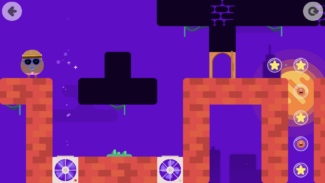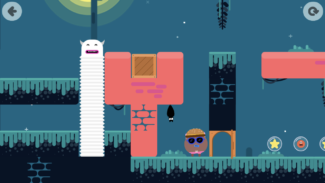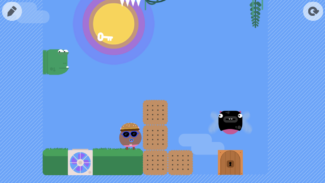Bastion
LQ: 9.15
Recommended Age: 10+
Skills Used: Planning, Working Memory, Mathematics, Reading
 Thinkrolls Play & Code is a logic puzzle and pre-coding game geared towards children ages 3-8. The latest game in the Avokiddo series, Play & Code allows your child to move colorful characters through mazes of physics and logic-based puzzles in order to earn stars and free smaller characters from bubbles. The player manipulates objects around them such as boxes, rocks, fans, and even other creatures to aid them in obtaining keys in order to move through several doors in each level.
Thinkrolls Play & Code is a logic puzzle and pre-coding game geared towards children ages 3-8. The latest game in the Avokiddo series, Play & Code allows your child to move colorful characters through mazes of physics and logic-based puzzles in order to earn stars and free smaller characters from bubbles. The player manipulates objects around them such as boxes, rocks, fans, and even other creatures to aid them in obtaining keys in order to move through several doors in each level.
There are three modes to the puzzles: Basic, Normal, and Hard so the player can start with simple ones or really challenge themselves right away. The harder the levels get, the more objects need to be moved in the correct order so that the player can successfully pass through.
 The Code Your Own option allows kids to take the game one step further and design a puzzle of their own. The player can learn pre-coding skills by dragging and dropping all of the various elements of Play and Code’s puzzles onto a blank canvas, allowing them to create something original and all their own. After creating their own puzzle, players can go to the Community Puzzles area and try puzzles created by other children. The player can also post their own puzzles in this section.
The Code Your Own option allows kids to take the game one step further and design a puzzle of their own. The player can learn pre-coding skills by dragging and dropping all of the various elements of Play and Code’s puzzles onto a blank canvas, allowing them to create something original and all their own. After creating their own puzzle, players can go to the Community Puzzles area and try puzzles created by other children. The player can also post their own puzzles in this section.
If the player wants to take a break from puzzling, there are also fun memory games that they can play such as Spot the Difference and Find the Odd. These are games to help strengthen Working Memory skills and increase in difficulty as the player continues to use them.
Thinkrolls Play & Code is available on iOS and features monthly or annual subscription options.
Flexibility: Adapting and adjusting to changing conditions and expectations.
 Even the most basic puzzles in Thinkrolls Play & Code have varying elements within them. These only increase in number as the puzzles get harder. This means that they player needs to use their flexibility skills in order to adjust to the circumstances of each puzzle. Players who are not flexible may find themselves starting over several times before they are able to get the puzzle right. To practice, players can start with the basic levels and work their way up to more complex ones when they feel they have grown comfortable with the changing circumstances. This way the changing elements are added a little bit at a time instead of all at once.
Even the most basic puzzles in Thinkrolls Play & Code have varying elements within them. These only increase in number as the puzzles get harder. This means that they player needs to use their flexibility skills in order to adjust to the circumstances of each puzzle. Players who are not flexible may find themselves starting over several times before they are able to get the puzzle right. To practice, players can start with the basic levels and work their way up to more complex ones when they feel they have grown comfortable with the changing circumstances. This way the changing elements are added a little bit at a time instead of all at once.
When students are creating their own puzzles they also need to be flexible and willing to test out many different versions until they strike upon the one that makes the most sense and can be played through successfully. For students who struggle adjusting and adapting, this can be good practice because there is no time limit and there are multiple ways in which a puzzle can be crafted. It allows the player to try new things within a safe space where everything they do is practicing for greater flexibility.
Planning: Developing a systematic approach for setting and achieving goals.
 Many of the puzzles in Thinkrolls Play & Code need the player to think a few steps ahead. This requires planning skills. If a player does not use planning, they may find that they moved a box to the wrong spot, moved into a position where they are now stuck, or blocked themselves from getting a key. Players who struggle with planning will find themselves resetting the puzzle a few times until they have gone through several options. This is good practice as it allows them to see their mistakes and eventually correct them. Starting with the more basic puzzles and working up to the Hard levels is a good course of action for players who need to practice planning.
Many of the puzzles in Thinkrolls Play & Code need the player to think a few steps ahead. This requires planning skills. If a player does not use planning, they may find that they moved a box to the wrong spot, moved into a position where they are now stuck, or blocked themselves from getting a key. Players who struggle with planning will find themselves resetting the puzzle a few times until they have gone through several options. This is good practice as it allows them to see their mistakes and eventually correct them. Starting with the more basic puzzles and working up to the Hard levels is a good course of action for players who need to practice planning.
For players who want to code their own puzzles, they will need to think several moves ahead to anticipate where the players need to go and how they will get there. There are many different elements that can be added to make the puzzles more difficult and the creator needs to see how all of them will work together in a way that makes sense to the player. This is also a great way to practice planning, as the player can simply try as many options as they want and then play test the puzzle themselves. The more complicated the puzzle, the more planning practice the player will get.
All membership plans come with full access to our entire suite of tools learning guides, and resources. Here are a few of the ones we think you’ll like the most: